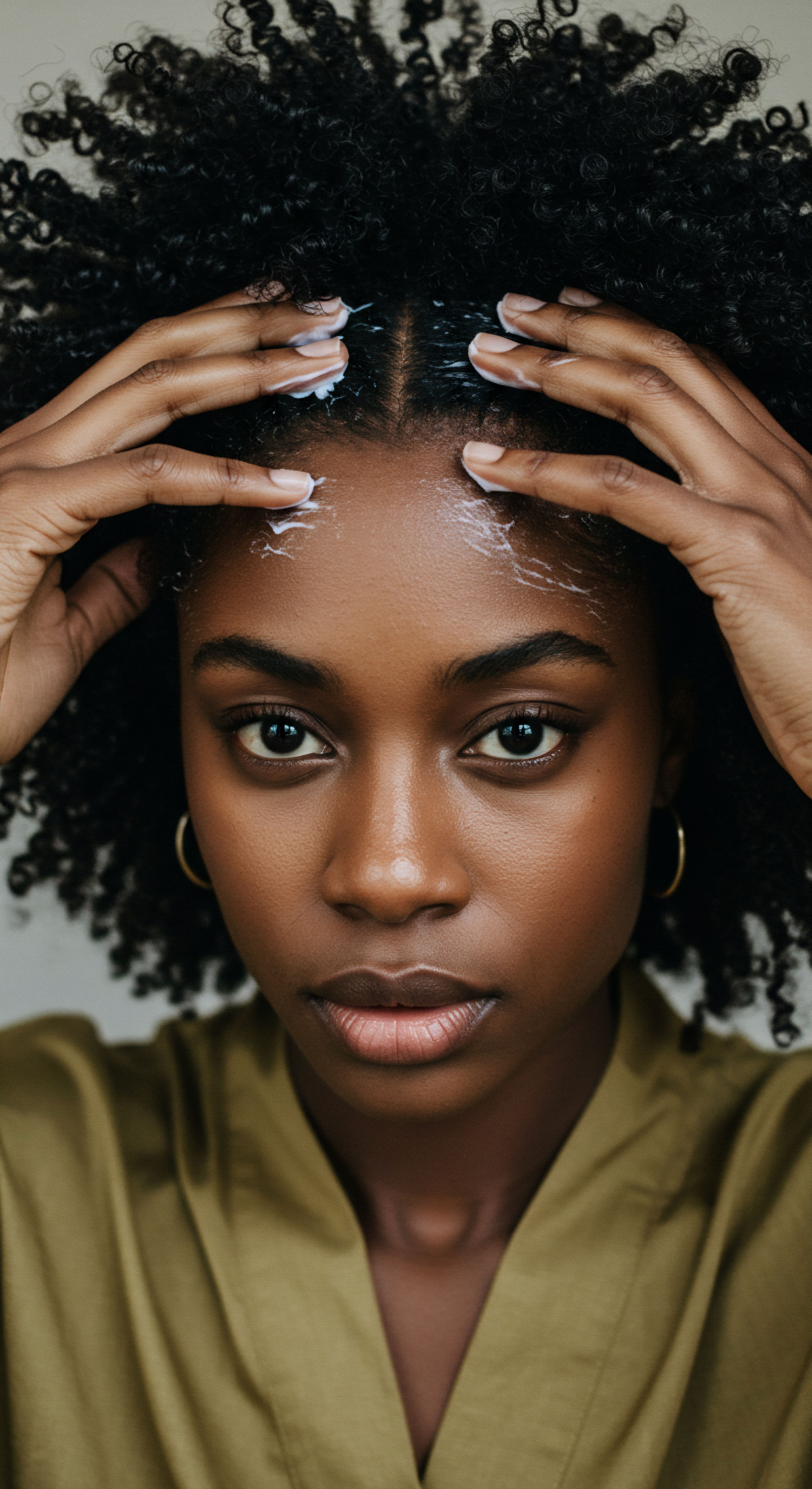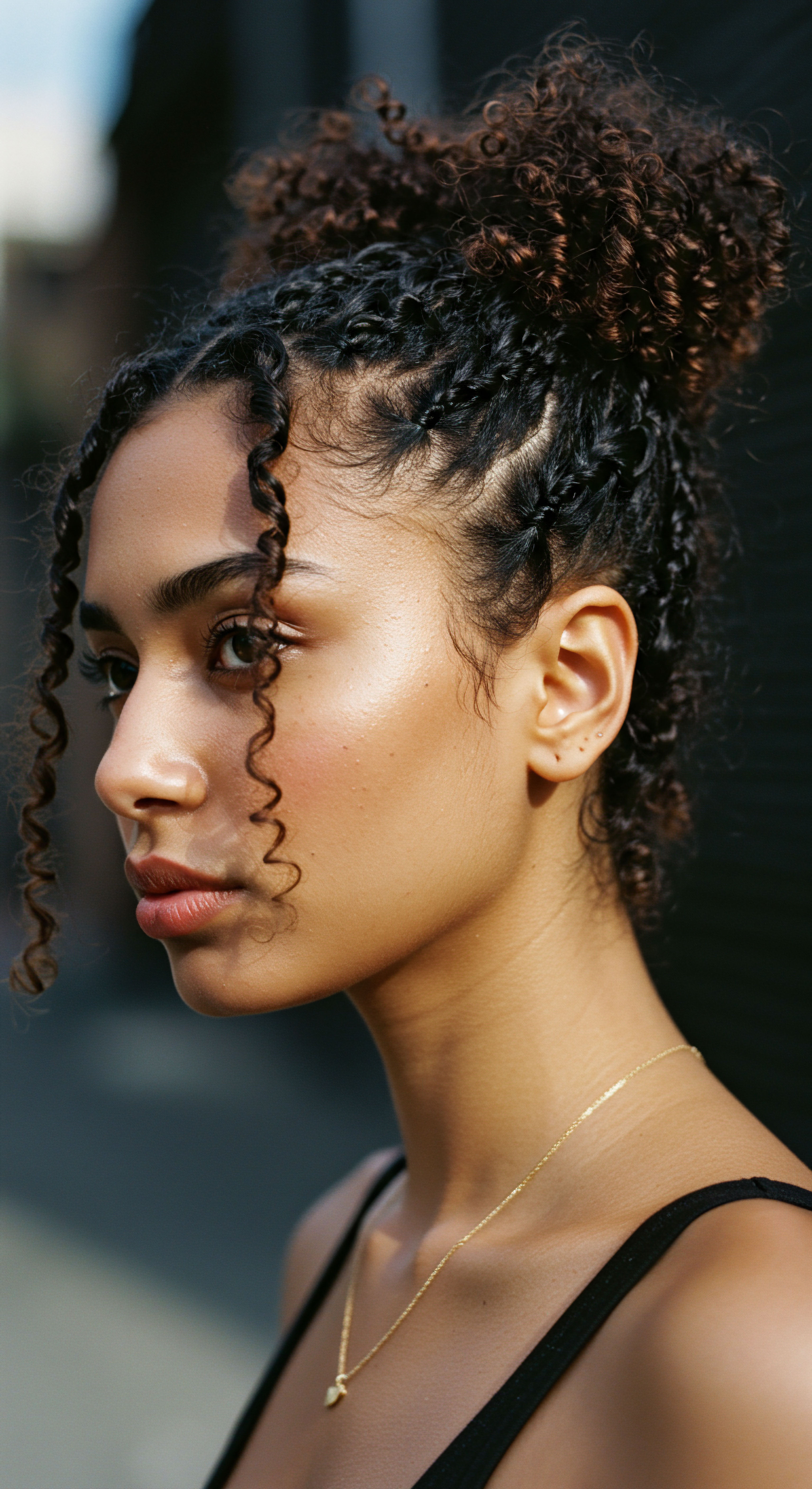
Roots
Our hair, a crown of identity, a personal story told in coils, kinks, and waves, holds secrets far deeper than its visible surface. We often consider its care a matter of what we apply, the gentle touch of a comb, or the protective embrace of a bonnet. Yet, the true foundation of its strength and resilience lies not in external rituals alone, but within the very building blocks of our bodies.
A quiet curiosity stirs when we consider the intimate link between our daily sustenance and the intricate biology that shapes our strands. Could the simple choices on our plates truly influence something as specific as hair ceramide production, those unsung heroes of our hair’s protective outer layer?
This section invites us to explore the foundational aspects of hair health, delving into its microscopic architecture and the essential components that give it life. We peel back the layers, not just of the hair shaft, but of our understanding, seeking the elemental truths that connect our internal world to the vibrancy of our hair.

Hair’s Inner World
A single strand of hair, though seemingly delicate, is a marvel of biological design. At its heart lies the Cortex, a central region comprised of keratin proteins, giving hair its strength and elasticity. Surrounding this core is the Cuticle, an outer layer of overlapping, scale-like cells, much like shingles on a roof.
This cuticle is the hair’s primary defense, its first line against the outside world. The integrity of this protective shield depends significantly on a specialized type of lipid, known as ceramides.
Ceramides are not merely a surface coating; they act as a cellular cement, binding the cuticle scales together and maintaining the hair’s barrier function. They are crucial for preventing moisture loss, preserving the hair’s natural hydration, and guarding against environmental stressors. When ceramide levels are compromised, the cuticle scales lift, leading to dryness, frizz, increased porosity, and susceptibility to breakage. The beauty and resilience we seek in our hair often trace back to the quiet, diligent work of these microscopic lipid guardians.
Hair’s strength and vibrancy are deeply rooted in its microscopic architecture, where ceramides function as vital cellular cement for the protective cuticle.

What Are Ceramides and Their Role?
Ceramides are a class of sphingolipids, complex lipid molecules present throughout our bodies, especially abundant in the skin and hair. In the hair, they are key components of the intercellular lipid matrix within the cuticle, working alongside cholesterol sulfate and other fatty acids. Their primary role is to create a hydrophobic barrier, preventing water from escaping the hair shaft and blocking the entry of harmful substances.
The specific types of ceramides found in hair include Ceramide NS, Ceramide NP, Ceramide EOH, Ceramide AS, and Ceramide AP, each with distinct fatty acid chains and roles in reinforcing the hair’s moisture barrier and structural integrity. For instance, Ceramide NS, present in the hair cortex, aids moisture retention, while Ceramide NP helps maintain the structural integrity of the hair cuticle. Ceramide EOH, located in the outermost cuticle, forms a protective surface barrier, and Ceramide AP, the most abundant hair ceramide, contributes significantly to moisture retention. A deficiency or disruption in this lipid layer can lead to increased porosity, dullness, and a propensity for damage.
| Ceramide Type Ceramide NS |
| Primary Location Hair Cortex |
| Role in Hair Reinforces moisture barrier, improves moisture retention. |
| Ceramide Type Ceramide NP |
| Primary Location Hair Cuticle |
| Role in Hair Maintains structural integrity, strengthens the cuticle. |
| Ceramide Type Ceramide EOH |
| Primary Location Outermost Cuticle |
| Role in Hair Forms protective barrier, prevents moisture loss. |
| Ceramide Type Ceramide AS |
| Primary Location Hair Cuticle |
| Role in Hair Strengthens lipid barrier. |
| Ceramide Type Ceramide AP |
| Primary Location Hair Cuticle |
| Role in Hair Contributes to moisture retention. |

Hair Growth’s Metabolic Demands
Hair growth is a highly active biological process, demanding a steady supply of nutrients to fuel the rapid cell division within the hair follicles. The hair follicle, a complex mini-organ, is the site where hair strands are formed. Its cells, particularly those in the dermal papilla and matrix, undergo continuous metabolic activity, requiring ample energy, proteins, lipids, vitamins, and minerals.
When the body experiences nutritional deficiencies, these essential building blocks become scarce, directly compromising the follicle’s ability to produce healthy hair. This can manifest as slowed growth, increased shedding, or changes in hair texture and strength. Understanding this fundamental connection sets the stage for exploring how our diet directly influences the creation of crucial components like ceramides, which in turn, determine the overall health and appearance of our hair.

Ritual
Our relationship with hair care often feels like a daily ritual, a series of deliberate steps to nourish and protect. But what if some of the most profound rituals happen not in our bathrooms, but in our kitchens? The understanding that what we consume holds sway over the vitality of our hair moves us beyond surface-level care, prompting a deeper consideration of how our plates serve as a canvas for our hair’s wellness. This section moves from the foundational to the practical, inviting a look at how dietary choices become an active, gentle practice in supporting ceramide production and, by extension, the health of our hair.

Nourishing the Hair From Within
The question of whether diet can affect hair ceramide production is a compelling one, prompting us to look beyond topical applications and towards systemic nourishment. The body synthesizes ceramides, and this process relies on the availability of specific precursor molecules and cofactors. These essential elements are, in turn, derived from the foods we consume.
Think of your diet as providing the raw materials for a complex internal workshop. Without the right components, the output is compromised. For hair ceramides, this means paying close attention to dietary fats, proteins, and a range of vitamins and minerals that act as catalysts or direct participants in lipid synthesis pathways. The subtle interplay of these nutrients creates the optimal environment for your body to produce the ceramides your hair needs to thrive.

Essential Fatty Acids and Hair Lipids
Among the most significant dietary components for ceramide production are essential fatty acids (EFAs), particularly linoleic acid (LA) and alpha-linolenic acid (ALA). These are fatty acids our bodies cannot produce on their own and must obtain from food.
- Linoleic Acid (Omega-6) ❉ LA is a direct precursor for the synthesis of ω-hydroxy-ceramides, a type of ceramide crucial for skin and hair barrier function. It is incorporated into complex lipid molecules, including CER (esterified omega-hydroxyacyl-sphingosine), which consists of an ultra-long N-chain fatty acid. Dietary sources rich in LA include safflower oil, sunflower oil, corn oil, soybean oil, and sesame oil. Research indicates that keratinocytes, the primary cells in hair and skin, are particularly efficient at absorbing LA.
- Alpha-Linolenic Acid (Omega-3) ❉ While ALA is primarily known for its anti-inflammatory properties, it also plays a role in overall lipid metabolism. A balanced intake of omega-3s (like ALA, EPA, and DHA found in fatty fish, flaxseeds, and walnuts) can support healthy cellular function, which indirectly benefits ceramide synthesis by maintaining a favorable metabolic environment. An imbalance favoring omega-6 over omega-3 can promote inflammation, which is detrimental to overall cellular health, including that of hair follicles.
These fatty acids contribute to the integrity of the hair’s lipid layers, both the surface lipids and the internal lipids within the cuticle. When these lipids are sufficient, hair retains moisture, appears shinier, and exhibits greater resistance to damage.
Essential fatty acids, especially linoleic acid, are fundamental building blocks for hair ceramides, underscoring diet’s profound influence on hair’s protective layer.

Protein and Amino Acid Contributions
Hair itself is primarily protein, mainly keratin. The synthesis of ceramides also requires specific amino acids. Serine, an amino acid, combines with palmitate to begin the de novo synthesis of ceramides in the endoplasmic reticulum. This foundational step highlights the necessity of adequate protein intake for overall hair health and the production of its protective lipids.
Sources of complete proteins, which provide all essential amino acids, include:
- Animal Proteins ❉ Meat, fish, eggs, and dairy. Eggs, for example, are a robust source of protein and biotin, both essential for hair growth.
- Plant Proteins ❉ Legumes, nuts, seeds, and whole grains. Soy, a plant-based protein source, contains isoflavones that have been shown to promote hair health.
A diet lacking sufficient protein can lead to weakened hair, increased shedding, and a compromised ability to synthesize essential components like ceramides, leaving hair vulnerable and dull.

The Role of Vitamins and Minerals
Beyond fats and proteins, a spectrum of vitamins and minerals acts as cofactors and regulators in the complex pathways of lipid and ceramide synthesis.
- B Vitamins ❉ Several B vitamins, including Niacin (B3), Pantothenic Acid (B5), and Biotin (B7), are vital. Niacinamide (a form of B3) has been shown to increase the biosynthesis of ceramides and other stratum corneum lipids, improving the epidermal barrier. Pantothenic acid has also shown to stimulate ceramide synthesis in keratinocytes. Biotin is essential for keratin production and is a cofactor for enzymes involved in lipid metabolism.
- Vitamin C ❉ This powerful antioxidant is crucial for collagen synthesis, which, while not directly ceramide, supports the structural integrity of the scalp and hair follicle environment. One study indicated that Vitamin C, along with calcium, can stimulate ceramide content in human keratinocytes.
- Vitamin E ❉ An antioxidant, Vitamin E helps protect fatty acids from oxidative damage, preserving the integrity of lipids, including those in the hair. Avocados, nuts, and seeds are excellent sources.
- Zinc ❉ This mineral supports wound healing and has anti-inflammatory properties, both beneficial for scalp health, which indirectly supports a healthy environment for ceramide production. Zinc also plays a role in regulating sebum production.
- Calcium ❉ Calcium is a modulator of cellular functions in keratinocytes and plays a role in skin barrier homeostasis. As mentioned, it has been linked to stimulating ceramide content in human keratinocytes when combined with Vitamin C.
The interplay of these micronutrients underscores that a truly comprehensive approach to hair wellness looks beyond isolated elements, recognizing the synergistic action of a well-rounded diet.

Relay
How does the nourishment we take in translate into the very fabric of our hair’s resilience? The journey from a bite of food to the creation of ceramides within a hair strand is a sophisticated biological relay, a testament to the interconnectedness of our body’s systems. This section steps into a more profound understanding, exploring the intricate metabolic pathways and systemic influences that govern ceramide production, drawing on research and insights that bridge the gap between diet, cellular biology, and hair’s structural integrity. We consider the subtleties often overlooked, those less apparent complexities that shape our hair’s protective capabilities.

The Biosynthesis of Hair Ceramides
The creation of ceramides within the body is a multi-step process, largely occurring in the endoplasmic reticulum and Golgi apparatus of cells, including keratinocytes within the hair follicle. The primary pathway, known as De Novo Synthesis, begins with the condensation of serine (an amino acid) and palmitoyl-CoA (a fatty acyl-CoA). This reaction forms 3-ketodihydrosphinganine, a precursor to sphingoid bases.
Subsequent steps involve reduction, acylation, and desaturation, ultimately leading to the creation of various ceramide species. The type of fatty acid added during acylation determines the specific ceramide formed, with very-long-chain fatty acids (VLCFAs) being particularly important for hair and skin ceramides. Enzymes known as ELOVL (elongation of very-long-chain fatty acids) are responsible for producing these VLCFAs. For instance, ELOVL1 is linked to the production of ceramides with C24 fatty acids, while ELOVL4 is responsible for ultra-long-chain fatty acids in the skin.
This intricate biosynthetic pathway highlights that the availability of precursor molecules (serine, palmitate, specific fatty acids) and the efficient functioning of the enzymes involved are paramount. Dietary components directly influence the supply of these precursors and the activity of these enzymes.

Dietary Precursors and Their Metabolic Routes
The influence of diet on ceramide production is not merely about providing raw ingredients; it extends to modulating the metabolic environment and enzyme activity.
Consider the impact of Dietary Sphingolipids themselves. While direct reutilization of intact dietary ceramides in hair is unlikely, research indicates that dietary sphingomyelin and glucosylceramide can be hydrolyzed in the small intestine into ceramide and sphingosine. These absorbed sphingoid bases might then be reused for endogenous sphingolipid synthesis or act as signaling molecules. Studies have shown that dietary sphingolipids can upregulate the expression of epidermal ceramide synthases (CERS), enzymes that create ceramides, contributing to ultra-long-chain ceramide synthesis.
For example, oral administration of purified glucosylceramide from plant extracts to hairless mice resulted in a 2-fold increase in epidermal ceramide synthase gene expression. This suggests a direct influence on the body’s machinery for ceramide creation.
Furthermore, the type of dietary fat can have profound systemic effects. A study in Sprague-Dawley rats demonstrated that High-Fat Diets (HFDs) could lead to reduced ceramide levels and lowered skin lipid content. This effect was linked to decreased mRNA levels of serine palmitoyltransferase (SPT), a key enzyme in ceramide synthesis, and HMG-CoA reductase, through lowered adiponectin and PPAR-α activity. Conversely, a balanced intake of monounsaturated fatty acids (MUFAs) in diets like the Mediterranean diet may inhibit the accumulation of certain ceramides that are linked to insulin resistance, suggesting a nuanced relationship between dietary fat composition and ceramide profiles throughout the body.
Dietary choices modulate ceramide production by supplying precursors and influencing the activity of enzymes crucial for lipid synthesis within hair follicles.

Beyond the Plate Systemic Influences
The story of diet and hair ceramides extends beyond direct precursors to encompass broader systemic health. The scalp microbiome, for instance, a complex community of bacteria and fungi, plays a role in maintaining scalp health and barrier function. While direct links to ceramide production are still under active investigation, a balanced microbiome can reduce inflammation and support the scalp’s overall environment, which is conducive to healthy hair growth and lipid synthesis. Diets rich in fats and sugars can provide energy for pro-inflammatory microbes, potentially disrupting this delicate balance.
Consider the fascinating insight from a 2018 Johns Hopkins study involving mice ❉ those fed a Western diet high in fat and cholesterol experienced decreased total ceramide levels in their skin, along with extensive hair loss and hair whitening. Intriguingly, treatment with an experimental compound, D-PDMP, which halts the production of certain fats called glycosphingolipids (GSLs) that are major components of cell membranes, noticeably increased ceramide levels to normal and reversed the hair loss and whitening. While this is an animal study and further human research is needed, it powerfully illustrates how dietary patterns can profoundly impact the body’s lipid composition and, consequently, hair health and ceramide levels. This research points to the complex interplay of dietary lipids, systemic metabolism, and hair’s very structure and appearance.

Cultural Dietary Practices and Hair Wellness
Across diverse cultures, traditional dietary practices have long been associated with vibrant hair. While not always directly linked to ceramide production in scientific literature, these practices often emphasize whole, unprocessed foods rich in the very nutrients discussed. For example, many traditional diets prioritize healthy fats from nuts, seeds, and certain animal sources, along with ample plant-based proteins and a spectrum of fruits and vegetables.
The Mediterranean diet, with its emphasis on raw vegetables, fresh herbs, and healthy fats, has been suggested as a useful complementary therapy for non-scarring alopecia due to its anti-inflammatory nutrients. This holistic approach to eating, deeply rooted in cultural heritage, provides a powerful context for understanding how diet, over generations, has been intuitively recognized as a cornerstone of overall well-being, including hair vitality. The wisdom embedded in these dietary traditions offers a gentle reminder that balance and whole-food nourishment often hold the key to unlocking our body’s inherent capacities, including the ability to produce essential protective components like ceramides.

Reflection
As we consider the intricate connections between our diet and the very structure of our hair, a quiet truth begins to surface ❉ the pursuit of hair wellness is a journey of deep self-acquaintance. It asks us to listen to our bodies, to honor the ancestral wisdom that often recognized food as medicine, and to appreciate the profound science that confirms these ancient intuitions. Our hair, in its magnificent textures and expressions, stands as a living testament to the harmony within. By choosing to nourish ourselves with intention, we do more than simply support ceramide production; we cultivate a deeper respect for our bodies, fostering a radiant presence that truly shines from within.

References
- Byun, H.J. Cho, M.K. (2012). Promotion of hair growth by newly synthesized ceramide mimetic compound. Korean Journal of Chemical Engineering, 29(12), 1699-1703.
- Duan, L. Miyazawa, K. Sakai, S. Kawashima, M. & Imokawa, G. (2012). Dietary sphingolipids improve skin barrier functions via the upregulation of ceramide synthases in the epidermis. Journal of Dermatological Science, 68(1), 16-24.
- Gu, X. et al. (2011). A high-fat diet reduces ceramide synthesis by decreasing adiponectin levels and decreases lipid content by modulating HMG-CoA reductase and CPT-1 mRNA expression in the skin. Molecular Nutrition & Food Research, 55(Suppl 2), S186-S192.
- Le Floc’h, C. Cheniti, A. Connétable, S. Piccardi, N. & Vincenzi, C. (2015). Effect of a nutritional supplement on hair loss in women. Journal of Cosmetic Dermatology, 14(1), 76-82.
- Letawe, C. Boone, M. & Piérard, G.E. (1998). Digital image analysis of the effect of topically applied linoleic acid on acne microcomedones. Clinical and Experimental Dermatology, 23(2), 56-58.
- Matsui, Y. et al. (2011). Double-Blind Study on Effects of Glucosyl Ceramide in Beet Extract on Skin Elasticity and Fibronectin Production in Human Dermal Fibroblasts. Journal of Nutritional Science and Vitaminology, 57(4), 285-290.
- Pazyar, N. & Feily, A. (2016). Nutrition of women with hair loss problem during the period of menopause. Journal of Cosmetic Dermatology, 15(2), 105-108.
- Pindur, L. & Schick, J. (2023). Hair Lipid Structure ❉ Effect of Surfactants. Cosmetics, 10(7), 107.
- Schmelz, M. et al. (1994). Sphingomyelin is hydrolyzed to ceramide and sphingosine in the small intestine after ingestion, and a portion of it is reused for sphingolipid synthesis. Journal of Biological Chemistry, 269(27), 18017-18025.
- Sugawara, T. et al. (2012). Dietary sphingomyelin and glucosylceramide enhanced mRNA expression of epidermal ceramide synthases (CERS), contributing to ultra-long-chain ceramide synthesis in the dry-skin hairless mouse model. Journal of Nutritional Science and Vitaminology, 58(2), 140-145.
- Szabo, G. et al. (2018). Experimental Drug Reverses Hair Loss and Skin Damage Linked to Fatty Diet, Shows New Study in Mice. Johns Hopkins Medicine News Release.
- Trommer, H. & Neubert, R.H.H. (2004). Niacinamide increases biosynthesis of ceramides as well as other stratum corneum lipids to improve the epidermal permeability barrier. International Journal of Pharmaceutics, 276(1-2), 195-201.
- Wagemakers, S.J. et al. (2022). The Role of Lipids in the Process of Hair Ageing. Polymers, 14(23), 5143.
- Wang, W. et al. (2022). The nutritional functions of dietary sphingomyelin and its applications in food. Frontiers in Nutrition, 9, 1024843.
- Yang, X. et al. (2023). The Role of Linoleic Acid in Skin and Hair Health ❉ A Review. International Journal of Molecular Sciences, 24(17), 13346.